Geography - Enlargement and reduction of maps | 11th Geography : Chapter 9 : Maps and Scale
Chapter: 11th Geography : Chapter 9 : Maps and Scale
Enlargement and reduction of maps
Enlargement
and reduction of maps
In the process of compiling maps cartographers
are often required to either reduce or enlarge maps. Reduction or enlargement
involves change in the size.
An enlargement provides the same map
but proportionally larger than the original.
A reduction gives the same map that
is proportionally smaller than the original.
The above image or map has been
reduced by ½ .The amount that an original image has been enlarged or reduced is
called a scale factor, or an enlargement or reduction factor. It is the constant factor by which all dimensions of an object
are enlarged or reduced in a map. If shapes have been reduced by half, the
scale factor is ½.
The ratio between the area of a map on one scale and its area to another scale is equal to the square of the ratios between the scales of the original and enlarged or reduced maps.
Graphical Method
Graphically maps can be enlarged or
reduced with the help of similar squares.
The square method is the most common
and simplest method for enlargement and reduction of maps. In order to enlarge
a map, cover the original map with a set of squares of equal sides. The side of
the squares has to be enlarged proportionally to that the original map. The side of the square of the new map has to
be determined using the formula.
Scale of the new map = New scale/old
scale x Side of the square of the original map.
Example:
This is a map of Rajasthan drawn on a
scale of 1/16,000,000 and is to be enlarged on the scale of 1/8,000,000.
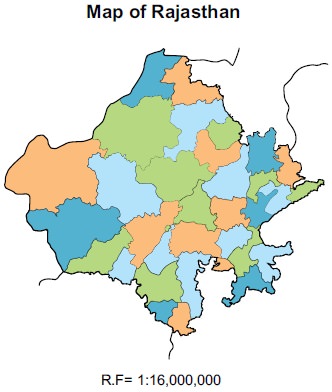
To enlarge the given map on the scale
of 1/8,000,000:
Step 1: Draw a network of
squares on the original map, each side being 1 cm. in length.
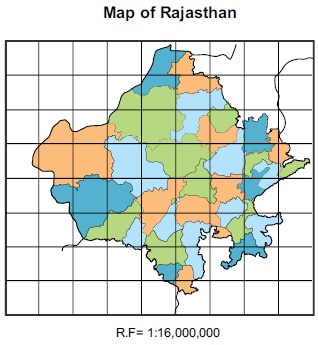
Step 2: Calculation
When the scale is 1/16,000,000 the
side of the small square is one cm.
For Scale of the map 1/16,000,000
side of the small square 51 cm
Therefore, If scale is to be
1/8,000,000 side of the small square of new map = x
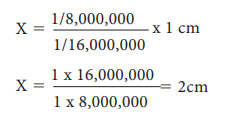
When the scale is 1/8,000,000 the
side of the small square will be 2cmNow draw a network of squares, each side
measuring 2 cm. The number of squares will be the same as on the original map.
Now transfer the outline of original map on the enlarged map square by square.
Example :
This is a map of Madhya Pradesh drawn
on a scale of 1/8,000,000 and is to be reduced on the scale of 1/16,000,000.
To reduce the given map on the scale
of 1/16,000,000.
Step 1: Draw a network of
squares on the original map, each side being 1 cm. in length.
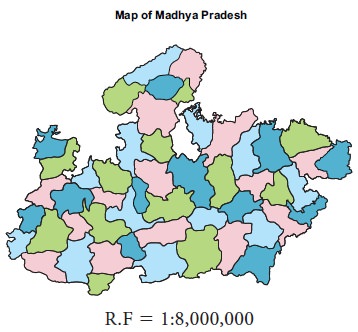
Step 2: Calculation
When the scale is 1/8,000,000, the
side of the small square is one cm.
For Scale of the map 1/8,000,000,
side of the small square 51 cm
Therefore, If scale is to be
1/16,000,000 side of the small square = x

When the scale is 1/16,000,000, the
side of the small square will be ½ cm
Now draw a network of squares each
side measuring 1/2 cm. of equal number
as on the original map and transfer
its outline on the reduced map square by square.
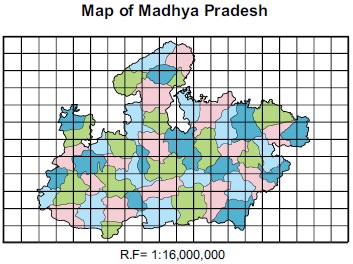
Example:
This is a map of Australia drawn on
the scale of 1/32,000,000 and is to be enlarged on the scale of 1/16,000,000.
The side of each square is ½ cm.
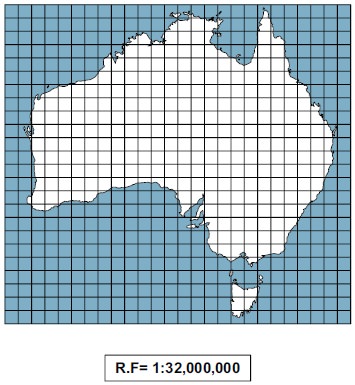
Calculation
To enlarged the given map on the
scale of 1/16,000,000:
In the given map, when the scale is
1/32,000,000 the side of the small square is ½ cm.
Therefore, If scale is to be
1/16,000,000 side of the small square = x
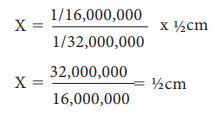
When the scale is 1/16,000,000 the
side of the small square will be 1 cm. Now draw a network of squares, each side
measuring 1 cm. The number of squares will be the same as on the original map.
Now transfer the outline of original map on the enlarged map.
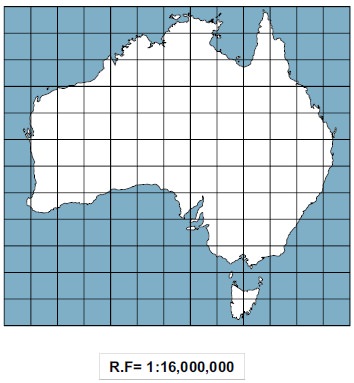
Exercise:
Trace the outline of any two
districts of Tamil Nadu from your atlas and enlarge and reduce the same.
Related Topics